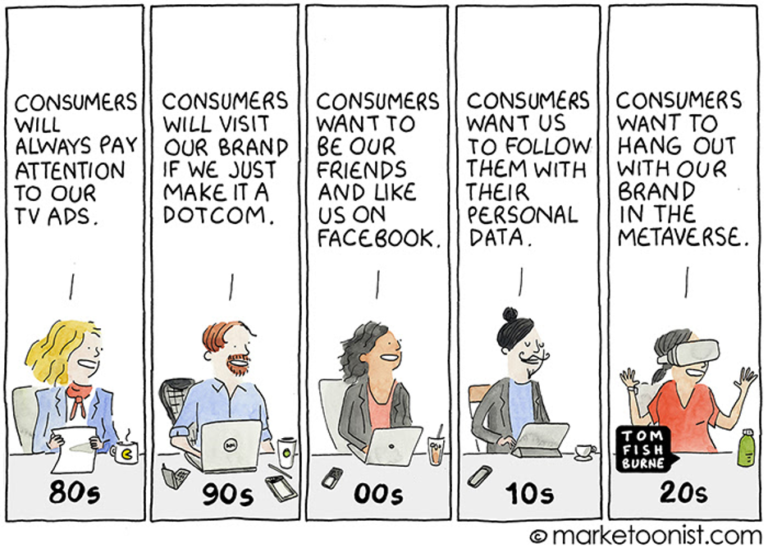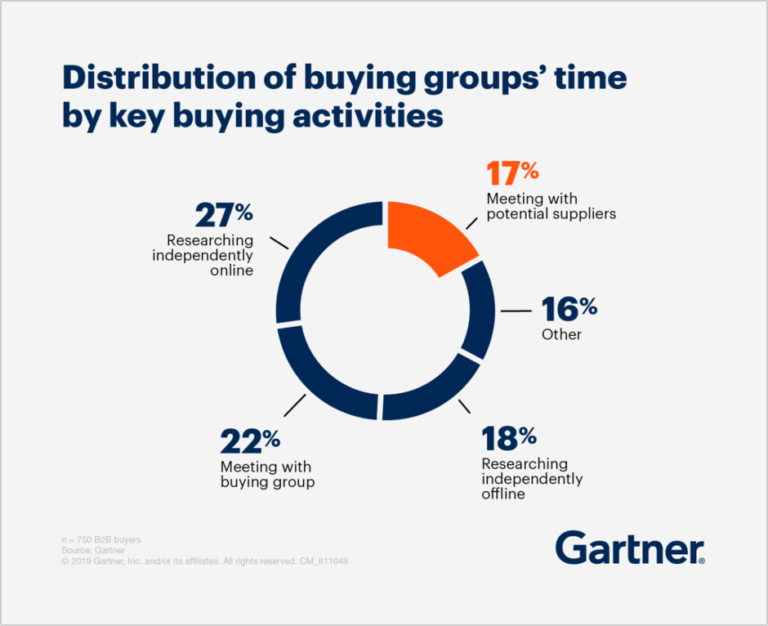The dark funnel is not some spooky Halloween marketing trend. But, it can be a pretty scary place for businesses when they haven’t yet embraced the work needed to capitalize on it.
We have all gotten addicted to analytics and measurements to help with everything from engagement to probability of closing. Today, however, we communicate and learn through a variety of other platforms that, like word-of-mouth advertising, are highly effective but difficult to quantify.
The “dark funnel” refers to channels that have an impact on your customers but are difficult or impossible to track.
And since 95% of B2B buyers are not ready to buy your product right now, you need to figure out where they are getting their presale information. Long before they ever do business with you, your customers discuss your product or industry with their coworkers, research on social media, and listen to podcasts.
Let’s discuss how to pivot your marketing to the dark side and find where your customers are hanging out today!

Lurking In the Dark Funnel
The dark funnel consists of all the different channels where your customers are doing their pre-buying research before ever contacting you. Unfortunately, they are also channels that are difficult to measure. Dark funnel marketing requires a shift in mindset.
Traditional marketing attribution models are deeply embedded in B2B organizations because they attribute success to what works. Stakeholders are more likely to give you money if you can show them how many people converted from previous campaigns.
When they are considering a purchase, B2B buyers only spend 17% of their time meeting with potential suppliers. The majority of their time is spent independently researching online and offline and consulting with the buying group.
Much of the purchasing process has already been completed by the time you see intent data.
Your buyers are seeking answers in hard-to-track locations:
- Communities and groups (e.g., Slack, Facebook Groups, Discord, Reddit, etc.)
- Social media platforms (e.g., LinkedIn, Twitter, Facebook, TikTok, etc.)
- Content platforms (e.g., Spotify, Apple Podcasts, YouTube, Twitch, etc.)
- Word-of-mouth interactions (e.g., text messages, DMs, video calls, etc.)
- Events (e.g., industry conferences, marketing meetups, VC groups, etc.)
Because buyer journeys are so complicated, the linear sales funnel, which goes from awareness to consideration to purchase, no longer gives an accurate picture of how people buy.
The shift in data privacy (phasing out of third-party cookies and Apple’s update asking apps not to track users) has us all needing to work harder to know where to interact.

Work Your Dark Funnel Backwards
Based on Gartner’s results, if over 80% of a customer’s journey is spent navigating dark channels, by the time they reach your website, their research is almost done. They’re arriving with an intent to buy.
Your job now is to convince them that buying your product is the best choice and make the conversion process as easy as possible. But, before investing in dark funnel marketing, optimize your website and landing pages.
Start by looking at quantitative data from Google Analytics to see how your web pages are performing, including traffic and conversions.
To get an idea of how people use your site, look at device mix, bounce rate, and top performing and top exit pages. You can use heat maps to see how users interact with individual pages.
This will help identify any performance and compatibility issues and what needs improvement.
Use this data alongside qualitative research from your sales team. Ask them:
- What are the top three questions you get from potential customers?
- What do you answer when you get these questions?
- Are there any particular aspects of the product/offer that people understand?
- What aspects of the product/offer do people like the most/least?
- Did I miss anything important? Got something to add?

How to Attract Leads in the Dark Funnel
To attract buyers in the dark funnel, you must bring your product and brand to them rather than the other way around. This is how you will develop relationships and initiate conversations that will convert prospects into sales-qualified leads.
However, being in the same circles as your target market is meaningless unless you engage with them and give them a reason to care. Here’s how to make your presence count.
Build Your Personal Brand to Get Closer to Your Audience
 Conversations in the dark funnel are people-driven. In most cases, joining a community as a brand is not possible. Even if it were, you can’t expect people to warm up to an entity the same way they would to a person.
Conversations in the dark funnel are people-driven. In most cases, joining a community as a brand is not possible. Even if it were, you can’t expect people to warm up to an entity the same way they would to a person.
The same goes for social media. While most people follow their favorite brands, meaningful conversations about products are all peer-to-peer on dark social, where they can’t be accurately tracked.
To build awareness and demand, build your personal brand to build your corporate brand.
Make use of your industry knowledge and expertise to establish yourself as a trusted expert. It’s a tactic used to great effect by many brands—particularly startups that often need to bootstrap in the beginning. Established companies can adopt this strategy.
According to Sprout Social research, 70% of people feel more connected to a brand whose CEO is active on social media, and 39% believe their presence provides better insight into a brand.
Create a separate identity from your brand, and encourage your employees to do the same. Get in front of your audience, share valuable insights, and build relationships to boost engagement. Be helpful for the sake of being helpful, and only bring up your brand when it is truly relevant.
Your personal brand will quickly grow, and so will your brand audience.
Create and Share Content that Helps People Solve Problems
 Your brand may use LinkedIn or Facebook to collect email addresses so that they can credit those channels. However, they are missing out on the conversations taking place in comment sections and groups.
Your brand may use LinkedIn or Facebook to collect email addresses so that they can credit those channels. However, they are missing out on the conversations taking place in comment sections and groups.
This is where people share information and make purchasing decisions. It’s also where you can shape the narrative surrounding your brand.
While your ultimate goal is to get people to visit your website and convert, your content’s goal is to create demand and educate your audience.
Avoid gated content and instead focus on freely sharing your knowledge.
Repurposing content makes it work harder and spreads its value further into channels and communities where your audience is active.
It gives value without expecting anything in return. This is what builds trust, attracts followers, and secures recommendations.
Begin by providing value. This will help you create demand and growth through organic social and content marketing.
Once people recognize and trust your brand, lead magnets can be shifted to paid marketing and retargeting. This way, when people see your ads, they’ll be more likely to take action.
So, where do you find ideas for value-driven content?
The answers lie with your customers.
Listen to Your Audience to Shape Your Marketing
 A competitive analysis is an essential component of any B2B marketing strategy. It helps you position your brand and product and positions you over your competition.
A competitive analysis is an essential component of any B2B marketing strategy. It helps you position your brand and product and positions you over your competition.
In the dark funnel, focus on what the customer is looking to do. What is your target audience discussing online? What questions are they asking? Use these questions and answers to help you create content. There’s no better way to endear yourself to an audience than by giving them solutions to real problems they’re having.
Social listening can be used similarly to monitor and analyze social media conversations. Don’t, however, do everything from the outside looking in. Remember, a lot of the discussions in the dark funnel can’t be monitored.
66% of buyers want more meaningful brand interactions. Spend time engaging in one-on-one conversations; listen to feedback, respond to questions, and address concerns.
According to McKinsey, over three-quarters of consumers are more likely to buy more and refer others to companies that offer personal interactions. Stay close to your audience to meet their needs and ensure positive brand engagement.
Deliver Consistency at Every Touchpoint
It takes time to generate demand. Getting to the point where your company is on everyone’s lips is a long-term strategy that is as much about how frequently you show up as it is about what you show up with.
According to Forrester research, the new number of B2B buying interactions post-pandemic is 27. Buyers are scouring the internet for information and gathering as much as they can before making a decision.
You have little chance of keeping up with how buyers discover and research options if you only publish something new once a month.
Develop a messaging strategy and share new content on a regular basis to stay top of mind. Dedicate some time each day or week to actively participating in groups, responding to comments, and creating fresh content. As you’ll be relying less on marketing automation software, it’s important to save time and resources where you can.
Pillar Content Helps With Dark Funnel Marketing
Instead of spending multiple hours per week creating original content, set aside some time to create pillar pieces that can be used to fuel other content and reach new audiences. One pillar piece can provide content for weeks or months without becoming stale.
Create consistency in your tone, messaging, and branding by following brand guidelines. The goal of consistency is to make yourself memorable in terms of presence, appearance, and sound at every touchpoint. Do this so that when buyers seek out new product or service recommendations, you’re the company getting the call.
Conclusion
Every day, opinions about your brand are formed and shared in the dark funnel. Being a part of the conversation allows you to tip the scales in your favor and get ahead of brands that are ignoring this untapped traffic.
Concentrate on your customers, show your human side, and build your content marketing funnel around solving problems.
Value will result in direct traffic from B2B buyers who spend the majority of their time gathering information from their networks. When it does, look at the big picture rather than specific metrics. Are sales representatives having more meaningful interactions with customers who are ready to buy? Is revenue increasing? These are indicators that dark funnel marketing is paying off.
If you are overwhelmed and need a place to start, get your marketing and sales cycle audited and remodeled! Schedule a call today.

